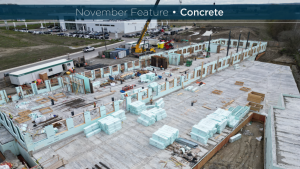Make errors preparing a bid for a drywall contract and you could be seeing red at the end of the day, says Hugh Laird, executive director of the Interior Systems Contractors Association of Ontario (ISCA).
Professional Development
ISCA program covers everything from software to accurate pricing
Bidding on work is serious business. Get the numbers right and at job completion you are smiling. Make errors preparing a bid and you could be seeing red at the end of the day.
Estimating can be a complex task, where practitioners often race against time to prepare accurate bids. With many young estimators being poorly trained, it is no wonder that mistakes are commonplace.
That, at least, is the scenario in the trade of drywall.
“When you learn from a dummy, you put out dummy numbers,” says Hugh Laird, executive director of the Interior Systems Contractors Association of Ontario (ISCA).
But Laird expects to hear less about estimating screwups because ISCA’s training centre has introduced a one-week course for drywall estimators. He believes it is the first drywall-specific estimating program in North America.
The course, which ran twice late this year and will go again several times next year, covers everything from estimating software applications to how to accurately read drawings to understanding the scope of work and how to accurately price a job.
A key objective: standardize the estimating process “so everybody is playing on the same field,” says Laird.
Experienced estimator Marcello Salvato, who sees the course as a good thing, says misreading an architect’s drawings is a common foul-up.
The chief estimator of Select Drywall & Acoustics adds that drawings of a wall assembly won’t show a 1.5-inch channel required to complete the wall. “Inexperienced estimators are likely to miss that.”
Salvato says estimators should organize the estimate according to the sequence of construction. Takeoffs of a residential highrise, for instance, should start with the exterior wall assemblies, then the firewall assemblies and then the actual suites.
Accurately pricing the labour can be as trying as quantity takeoffs. And, because there are no standard guidelines in the industry, huge quotation differences between one contractor and another often result, say experts.
At ISCA’s one-week estimating course, students learn a standard method of color coding to identify wall types and assemblies on a drawing’s legend.
Salvato is a fan of color coding. “Once you finish a takeoff and you look at all of the various colors you have assigned, then you know that you haven’t missed anything.”
Furthermore, it ensures that any estimator can quickly decipher another estimator’s work.
The course also covers drywall-specific computer software applications including On-Screen Takeoff and QuickBid.
Both are “finisher dedicated” programs that allow estimators to generate building materials and pricing at a faster rate than possible using conventional spreadsheet software, explains Clint Kissoon, head instructor of the course.
He says one of the QuickBid’s features allows users to easily readjust bids with last-minute changes that could make or break a bid.
Kissoon, who also heads a construction technology program at Toronto’s George Brown College, says contractors should use software tailored to their field. Many programs for general contractors can be used by drywall trades but not without customization. And they are expensive, running $3,000 to $5,000 each.
While software like QuickBid and On-Screen Takeoff are good tools for estimators, Salvato prefers a customized version of Microsoft Excel, complete with user forms and codes in conjunction with a digitizer to measure quantities quickly.
With all the merits of today’s software, many older estimators still prefer to do takeoffs manually or on a simple spreadsheet program. And they often don’t double check their work, points out Salvato.
To avoid “big mistakes,” he says estimators should learn how to apply ratios — an important cross-checking tool. For example, if the known ratio of finished drywall for a gross floor area with nine foot ceilings is 3, when an estimate comes in at a ratio of 2.5, than the estimator knows something’s askew.
He says when he started in estimating 10 years ago, few experienced estimators applied ratios. “Some of them would sort of close their eyes and hope they made a profit at the end of a job.”
ISCA’s crash course in estimating has proved popular beyond Ontario’s boundaries. The first class held in October brought students from as far away as Florida and Alaska. Laird, who heavily marketed the course south of the border, says it is proof that other estimating courses in North America aren’t specific to drywall. Tuition is $500 Canadian for Ontarians and $1,200 for out-of-province and American students.
It is not just drywall contractors that are making bidding errors, though. Kissoon has seen big mistakes made by general contractors. In one instance it was a million-dollar error. “The biggest nightmare for most estimators is taking information and transferring it onto a spreadsheet without forgetting something that is a big number.”










Recent Comments
comments for this post are closed